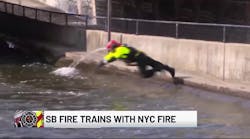This University of Extrication column is the third in a multi-part series presenting advanced technician-level vehicle rescue training scenarios. This article describes a challenging jammed door evolution that meets the criteria of a technician-level skill and competency of NFPA Standard 1670.
This scenario requires a team to stabilize a side-resting vehicle, climb to the top side and then open and remove a simulated jammed door. A real-world situation where this very task may be necessary could include an incident where a vehicle went off the roadway and wedged in a deep ravine. It is possible that only the top side of the vehicle would be accessible. This assignment will require that the top side door be forcibly opened and completely removed.
Opening a Jammed Door on a Side-resting Vehicle
To set up for this scenario, a vehicle must be placed on its side, preferably with the driver’s side down. The simulation is that the driver is trapped inside. Rescuers must stabilize the vehicle, then access the top of the vehicle. Personnel and equipment needed to open and then remove the top side door will work along the top edge of the vehicle.
A four-person team should be capable of accomplishing this task in six minutes or less. Several members will be “ground support” personnel while one or two will work on the high side of the vehicle.
As with all of our side-resting scenarios in this series, the most effective stabilization tactic is to utilize a tensioned buttress stabilization system. The vehicle must be assured to be stable because personnel will be working with power tools on the top side.
All jammed door tactics that are used on a typical door job at ground level are able to be used in this side-resting scenario as well. The big difference is that all the door work will take place about six feet off the ground and gravity will work against you in every aspect of this task. Another difference is that personnel are not used to balancing on the top of a vehicle or on a ground ladder while working with rescue tools. What was once easy to accomplish at ground level becomes more difficult and time-consuming simply due to the position of the vehicle.
The first challenge comes when rescuers realize they must remove the tempered glass in the door or window frame. This pane of glass weighs typically four to six pounds and should not simply be broken out without regard for those who would be beneath the glass in a real-world situation. The crew must devise a method of “capturing” the glass nuggets as the glass breaks. Holding a tarp, blanket or even a vehicle floormat beneath the window on the inside of the vehicle may help catch the glass and divert it away from the interior medics and patients who would be there in a real incident. Taping the glass is possible, but only if the outer glass is dry and at normal temperature. Rolling the window down and breaking the glass inside the door is a good idea, but this might not be possible in a vehicle with electric windows.
Once personnel access the high side by climbing either a ground ladder or the vehicle’s undercarriage itself, the simulated jammed door can be attacked at the hinges or at the latch, depending upon the desire of the crew working the job. The fender can be crushed to expose the front hinges just like you might do on the ground. This time, however, tool balance, access to the proper area of the vehicle and the position of the rescuer on the top of the vehicle make even this basic task difficult. With the hinges exposed, cutting tools can sever the hinges themselves. Personnel can work from either a ground ladder or balance themselves on the vehicle itself while working the tools.
A latch attack to force the door open is similar to a standard door job except for the fact that the door is above ground level. Any ladder used to access the upper side of the vehicle must not be leaning on the door or cannot block it from opening as it is pried open. Personnel working the rescue tools on the high side must remain off the door itself as it is being opened. All things being equal, it may work better to attack the door at the latch, then open the door and push it past its normal range of opening. Ground crew members can then pull on a tag line placed on the door to hold it toward the front fender while the hinges are attacked by the top side crew.
Once the latch and the hinges have been taken care of, the door must be removed from the vehicle and lowered to awaiting crew members on the ground. This is where the weight of the door becomes a reality more so than when crews are working a jammed door of a vehicle on four wheels. The front door of a vehicle will typically weigh 50 pounds or more and with a side-resting vehicle, that can be quite a challenge to control as it is lowered to the ground.
TASK: Given the scenario of a side-resting vehicle with a “patient” trapped inside, open and remove a simulated jammed door of the vehicle while it is in a side-resting position.
Ron Moore, a Firehouse® contributing editor, is a battalion chief and the training officer for the McKinney, TX, Fire Department. He also authors a monthly online article in the Firehouse.com “MembersZone” and serves as the Forum Moderator for the extrication section of the Firehouse.com website. Moore can be contacted directly at [email protected].







